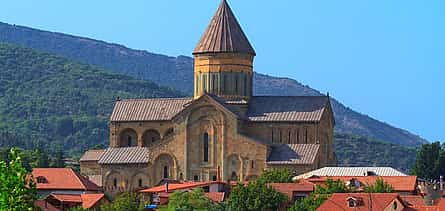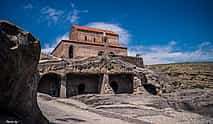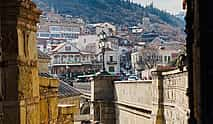



Exploring Georgia, 6 days (no accommodation) in Tbilisi
Immerse yourself in the beautiful charms of this welcoming country.
Highlights:
- Discover Tbilisi
- Visit Jvari, where Lermontov's poem Mtsyri takes place
- Explore Uplistsikhe, Georgia's first cave city
- Taste wine in Kakheti
- Taste Borjomi's healing water
- Marvel at Kazbegi peak
The price includes:
- all the journeys along the route in a comfortable transport
- guide-driver service
- trips according to the itinerary
- ascent to Gergeti on a 4x4 off-road vehicle
- dinner at a Georgian family, wine tasting and a master class in Georgian cuisine
Extra charge:
- health insurance
- hotel accommodation in Tbilisi
- entrance tickets according to the tour program
- alcoholic beverages not included in the program
- personal expenses and other services not mentioned above
- Transfer from/to airport-hotel in Tbilisi
Program of the tour:
1 day. TBILISI
Walking tour of the Old City (Metehi Temple Narikala Fortress Sulfur Baths Mosque Meydan Square Sharden Street Sioni Temple Anchikhati Church Peace Bridge). Lunch (extra charge). Free time for independent exploring of the capital.
Optionally, you can book a dinner at a restaurant with Georgian dancing.
Day 2. DJVARI-MTSKHETA-UPLISTSIKHE.
Breakfast at the hotel. We set out on a journey to the iconic places of the country. Visiting the Temple Jvari ("Temple of the Holy Cross"), built in the VI century. It stands on a high mountain, which offers a beautiful panorama of the confluence of two great rivers Aragvi and Mtkvari. According to legend, on the same mountain erected a cross herself Holy Equal-to-the-Apostles Nino. Jvari is the first UNESCO World Heritage Site in Georgia. In addition, Jvari is said to be the same monastery, which Lermontov wrote about in his poem "Mtsyri. The ancient capital of the Eastern Georgian kingdom of Kartli (Iberia) Mtskheta. It is a holy and iconic place for every Georgian. The city was founded in the 2nd half of the 1st millennium BC. The city remained the capital until the 5th century A.D. Mtskheta is called the "Second Jerusalem" for its unique Christian relics. We will visit the Temple of Svetitskhoveli (which means "Life-giving Pillar" in the base of which is buried one of the main relics of Christianity, the Chiton of the Lord, and it's also the burial place of many kings of Georgia). We will also visit the ancient monastery of Samtavro (where St. Nino lived and preached in the 4th century).
And then go to Uplistsikhe first Georgian cave city. The city is thought to have been formed around 1000 BC, and was finally deserted only in the 19th century. Before Christianity Uplistsikhe was a sacred, religious center of the state of Kartli (Iberia). The main temple was the Temple of Sun on the highest point of the city. The caves in Uplistsikhe, which are grouped and connected to each other by pathways, can be seen nowadays. Some of the caves (the central ensemble, palace complex, and churches) are richly ornamented.
Back to Tbilisi.
Day 3. TBILISI - UJARMA-TELAVI - TSINANDALI-KVARELI - TBILISI
This day we will travel through Kakheti region. Our first object is the city - Ujarma fortress. The city was founded around III. century AD and was famous for being the residence of King Vakhtang Gorgasali (2nd half of V century). The city fell into decay after the fortress was destroyed by the Arabs in the X century. The upper part of the fortress was reconstructed only in XII century, during the reign of queen Tamar's father - Giorgi III who arranged here a treasury. In the later Middle Ages the fortress was used by local feudal lords. This fortress is also known because, according to legend, here St. Nino "erected one of the three crosses (the first cross was erected on the site, where now is the monastery Dzhvari, the second cross on Mount Thoth).
Then through the Gombori Pass we drive to Telavi, the capital of the Kakheti region. The city is located in the Alazani valley, on the slope of the Tsivi-Gombori range, 490 m above sea level, so the air here is fresh and the scenery is spectacular. Telavi is the oldest city in Georgia, along with Tbilisi, Mtskheta and Kutaisi. It is known from I-II centuries AD and was once an important trade center on the caravan route from the Middle East to Europe. We will walk around the city for a while, try to embrace a 900 year old sycamore tree and enjoy the views.
Our next stop is Tsinandali estate (Alexander Chavchavadze's house-museum), which attracts visitors with its history, beautiful park and famous wine cellar (wine tasting is optional). Alexander Chavchavadze (1786 1846) was a brilliantly educated aristocrat, a combat general, a participant in the war with Napoleon, a wise politician, an active public figure and a poet. Alexander Pushkin, Alexander Griboyedov and the Decembrists liked to visit his house. It was at the initiative of the prince that the traditional artisanal production of Georgian wine was transferred to an industrial basis. Nina Chavchavadze (daughter of A. Chavchavadze) was the wife of A. Griboyedov. We will visit the house-museum and take a walk in the park. Here you can take marvelous photos against the beautiful nature.
Then we go to Kvareli, where you'll meet a Georgian family, which has its own vineyards, marani, and beautiful wine of its own production. A delicious lunch, introduction to the traditions of Georgian winemaking, wine tasting, and master-classes on cooking Georgian dishes await us.
Back to Tbilisi.
Day 4. BORJOMI
Borjomi is a pleasant, spa-like green town, which is located in the Borjomi gorge and is famous for its mineral water. The Nature and the unique healing climate is marvelous here. But exactly thanks to the mineral water of Borjomi, it became world famous. This is a gorge town, and due to this all its buildings are stretched in line along the river bank for about 5 km. The architecture of Borjomi is absolutely unique for Georgia. At one time there were different styles of mansions built here, up to the mysterious-looking castles. We are going to walk along the beautiful Borjomi Park, and taste the mineral water directly from the springs. Optionally we visit Borjomi Museum of Local History (one of the most interesting), or take a bath in the sulfur pool (for extra fee).
Return to Tbilisi.
Day 5. ANANURI - CROSS PASS - KAZBEGI
We leave for the highland region of the country. Our way to the mountains is by the Georgian Military Road (VGD). The construction of this road began in the late 18th century, after the signing in 1783 of the Georgievski Pact on the protectorate of the Russian Empire over Georgia. For a long time it was the only road from Russia to Georgia and generally to the Caucasus. On the way we will visit the fortress of Ananuri. The fortress was built in the 16th century. It was a residence of Aragvi feudal lords, rulers of the region, who played an important role in political life in eastern Georgia in the 17th century. Ananuri was the key to the Aragvi Gorge. It has been attacked and destroyed many times, but a large part of the fortress has survived. Even today this construction evokes a feeling of power and strength. The fortress offers wonderful views of the river Aragvi and the picturesque Zhinval water reservoir.
Then we go by the famous ski resort of Gudauri and cross pass, named after the famous stone which Pushkin, Griboyedov and Lermontov passed in 1824 at the height of 2379 meters. Arrival in the district of Kazbegi (Stepantsminda). Here at an altitude of 2170 m is a wonderful Church of the Trinity of the Gergeti (XIV century). This is quite a big church from below seems a tiny point on the background of the giant mountain Kazbek (5047 m), covered with eternal snow. Near the church is a monastery complex, where the monks live to this day. Going up to the church by four-wheel drive, touring it and admiring the beautiful views of the mountains.
Return to Tbilisi.
Day 6. TBILISI.
Free time.